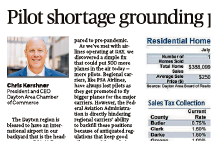Kershner: Pilot Shortage Grounding Planes at DAY
View Article as Featured in Dayton Daily News
 The Dayton region is blessed to have an international airport in our backyard that is the headquarters to PSA Airlines, a regional jet carrier for American Airlines. Dayton International Airport (DAY) serves the business community, creates a nexus with logistics and freight distribution and provides access for Dayton residents to anywhere in the world. For the Dayton International Airport to be successful, our business community is continually working with DAY to identify new destinations and new airline service to serve our corporate partners. However, if you have flown recently, you know that crew shortages are causing flight cancellations everywhere, and airports have a fraction of the flights compared to pre-pandemic.
The Dayton region is blessed to have an international airport in our backyard that is the headquarters to PSA Airlines, a regional jet carrier for American Airlines. Dayton International Airport (DAY) serves the business community, creates a nexus with logistics and freight distribution and provides access for Dayton residents to anywhere in the world. For the Dayton International Airport to be successful, our business community is continually working with DAY to identify new destinations and new airline service to serve our corporate partners. However, if you have flown recently, you know that crew shortages are causing flight cancellations everywhere, and airports have a fraction of the flights compared to pre-pandemic.
As we’ve met with airlines operating at DAY, we discovered a simple fix that could put 500 more planes in the air today—more pilots. Regional carriers, like PSA Airlines, have always lost pilots as they get promoted to fly bigger planes for the major carriers. However, the Federal Aviation Administration is directly hindering regional carriers’ ability to backfill these positions because of antiquated regulations that keep good pilots out of the cockpit and are grounding planes at regional jet airports like DAY. If we can get more well-trained, safe pilots into the cockpit, then PSA Airlines alone could put dozens of more planes back in the air today. That means more planes at DAY, more flights for DAY and more destinations for Dayton businesses.
In 1959, the FAA required that pilots retire at age 60 and in 2007 they increased this mandatory retirement age to 65. The FAA’s current 65 age rule isn’t based on pilot training, safety or pilot performance. If a pilot’s age is 65 years and 1 day, that doesn’t make them a bad pilot. Additionally, new pilots are required to have 1,500 hours of flight training at a cost of about $200,000 before they can be in the cockpit of a jet. To get their training hours, many pilots fly single engine planes like crop dusters. I’m not a pilot, but I can tell you that single engine planes are not the same as a regional commuter plane with two jet engines, 75 passengers and modern aeronautics. The FAA needs to get out of the dark ages, change the rules and allow these pilots to meet their requirements with modern technology and simulators that mimic real world planes and environments. And by the way, at a cost of $200,000, we have a real world equity issue that is putting pilot training out of reach for thousands of students.
As we look to immigration reform and creating legal pathways for foreign workers to support our business community, we can’t ignore Visa waivers and flight training reciprocity for foreign pilots that can come to the U.S. and put more planes in the air. Regional jet airports like DAY will always lose pilots to the major carriers, but we have easy solutions right in front of us that will help DAY return air service, compete with bigger airports and get more direct destinations out of Dayton. It’s 2022 and we have access to technology that is safer, more efficient and will put more pilots in planes at our hometown airport. Let’s use it!
Chris Kershner, CAE
President & CEO
Dayton Area Chamber of Commerce
Download a PDF of this article as it appeared in the Dayton Daily News.








